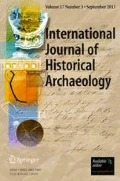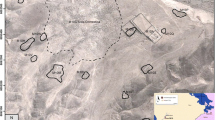Abstract
Cilliní—or children’s burial grounds—were the designated resting places for unbaptized infants and other members of Irish society who were considered unsuitable by the Roman Catholic Church for burial in consecrated ground. The sites appear to have proliferated from the seventeenth century onwards in the wake of the Counter-Reformation. While a number of previous studies have attempted to relate their apparently marginal characteristics to the liminality of Limbo, evidence drawn from the archaeological record and oral history accounts suggests that it was only the Roman Catholic Church that considered cilliní, and those interred within, to be marginal. In contrast, the evidence suggests that the families of the dead regarded the cemeteries as important places of burial and treated them in a similar manner to consecrated burial grounds.





Similar content being viewed by others
References
Aldridge, R. B. (1969). Notes on children’s burial grounds in Mayo. Journal of the Royal Society of Antiquaries of Ireland 99: 83–87.
Archer, J. (1999). The Nature of Grief: The Evolution and Psychology of Reactions to Loss, Routledge, London.
Ariès, P. (1973). Centuries of Childhood, Jonathan Cape, London.
Ballard, L. M. (1985). “Just whatever they had handy”: Aspects of childbirth and early child-care in Northern Ireland, prior to 1948. Ulster Folklife 31: 59–72.
Berg, S. J., and Wynne-Edwards, K. (2001). Changes in testosterone, cortisol, and estradiol levels in men becoming fathers. Mayo Clinical Proceedings 76: 582–592.
Bradley, R. (1993). Altering the Earth, Alan Sutton, Stroud.
Church, C. (1995). Catechism of the Catholic Church: Pocket Edition, Veritas, Dublin.
Cecil, R. (1996a). Memories of pregnancy loss: recollections of elderly women in Northern Ireland. In Cecil, R. (ed.), The Anthropology of Pregnancy Loss, Berg, Oxford, pp. 179–196.
Cecil, R. (1996b). Introduction: An insignificant event? Literary and anthropological perspectives on pregnancy loss. In Cecil, R. (ed.), The Anthropology of Pregnancy Loss, Berg, Oxford, pp. 1–14.
Church of Ireland (1960). Book of Common Prayer and Administration of the Sacraments and other rites and ceremonies of the Church according to the Use of the Church of Ireland (first edition 1549), Association for Promoting Christian Knowledge, Dublin.
Clarke, L. (2002). An early medieval enclosure and burials: Johnstown, Co. Meath. Archaeology Ireland 16(4): 13–15.
Cooper Foster, J. (1951). Ulster Folklore, H. R Carter, Belfast.
Crombie, D. (1990). Children’s Burial Grounds in County Galway. Unpublished master’s thesis, National University of Ireland, Galway.
Curl, J. S. (1986). The Londonderry Plantation, 1609–1914, Phillimore, Sussex.
deMause, L. (1974). The evolution of childhood. In deMause, L. (ed.), The History of Childhood, Psychohistory Press, New York, pp. 1–73.
Dennehy, E. A. (1997). The Cellúnaigh of County Kerry: An Archaeological Perspective. Unpublished master’s thesis, University College Cork
Dennehy, E., and Lynch, L. (2001). Unearthed secrets: A clandestine burial-ground. Archaeology Ireland 15(4): 20–23.
de Paor, L. (1974). Inishcaltra (Holy Island): monastic site. In Delaney, T. G. (ed.), Excavations 1973: Summary Accounts of Archaeological work in Ireland. AYIA, HIS, and the UAS, Belfast, pp. 5–6.
Donnelly, C. J. (2004). Masshouses and meetinghouses: The archaeology of the Penal Laws in early modern Ireland. International Journal of Historical Archaeology 8: 119–132.
Donnelly, C. J., and Murphy, E. M. (2008). The origins of cilliní in Ireland. In Murphy, E. M. (ed.), Deviant Burial in the Archaeological Record, Oxbow Books, Oxford, pp. 191–223.
Donnelly, S., Donnelly, C., and Murphy, E. (1999). The forgotten dead: The cilliní and disused burial grounds of Ballintoy, County Antrim. Ulster Journal of Archaeology 58: 109–113.
Duggan, K. (2004). The Lifelong Season: At the Heart of Gaelic Games, Town House, Dublin.
Fanning, T. (1981). Excavation of an Early Christian cemetery and settlement at Reask, County Kerry. Proceedings of the Royal Irish Academy 81C: 67–172.
Finlay, N. (2000). Outside of life: Traditions of infant burial in Ireland from cillín to cist. World Archaeology 31: 407–422.
Fletcher, A. (2008). Growing up in England: The Experience of Childhood 1600–1914, Yale University Press, New Haven.
Flower, R. (1978). The Western Island, Oxford University Press, Oxford.
Francis, D., Kellaher, L., and Neophytou, G. (2005). The Secret Cemetery, Berg, Oxford.
Gannon, P. (1999a). Sméaróid. In Gannon, P. (ed.), The Way It Was, Paul Gannon, Renvyle, pp. 142–154.
Gannon, P. (1999b). Consummatus in brevi. In Gannon, P. (ed.), The Way It Was, Paul Gannon, Renvyle, pp. 135–41.
Garattini, C. (2007). Creating memories: Material culture and infantile death in contemporary Ireland. Mortality 12: 193–206.
Gélis, J. (1991). History of Childbirth. R. Morris (trans.), Polity Press, Cambridge.
Gilchrist, R., and Sloane, B. (2005). Requiem: The Medieval Monastic Cemetery in Britain, Museum of London Archaeology Service, London.
Gillespie, R. (1993). Plantations in early modern Ireland. History Ireland 1(4): 43–47.
Gross, D. M. (2006). The Secret History of Emotion: From Aristotle's Rhetoric to Modern Brain Science, University of Chicago Press, Chicago.
Hamlin, A., and Foley, C. (1983). A women’s graveyard at Carrickmore, County Tyrone, and the separate burial of women. Ulster Journal of Archaeology 46: 41–46.
Hurl, D. P., and Murphy, E. M. (1996). Life and death in a County Antrim tower house. Archaeology Ireland 10(2): 20–23.
Jalland, P. (1996). Death in the Victorian Family, Oxford University Press, Oxford.
Johnson, M. (2010). Archaeological Theory. An Introduction, Wiley-Blackwell, Chichester.
Jones, W. (1990). Miscarriage: Overcoming the Physical and Emotional Trauma, Thorsons, Wellingborough.
Kelly, J. (1992). Infanticide in eighteenth century Ireland. Irish Economic and Social History 19: 5–26.
Lynch, L. G. (1998). Placeless Souls: Bioarchaeology and Separate Burials in Ireland. Unpublished master’s thesis, University College Cork.
McKerr, L., Murphy, E., and Donnelly, C. (2009). “I Am Not Dead, but Do Sleep Here”: The representation of children in Early Modern burial grounds in the north of Ireland. Childhood in the Past 2: 110–132.
Montgomery, H. (2008). An Introduction to Childhood: Anthropological Perspectives on Children’s Lives, Wiley-Blackwell, Oxford.
Moulder, C. (1998). Understanding Pregnancy Loss, Macmillan, London.
Murphy, E. M., and McNeill, T. E. (1993). Human remains excavated at Doonbought Fort, Co, Antrim, 1969. Ulster Journal of Archaeology 56: 120–138.
Mytum, H. (2004). Mortuary Monuments and Burial Grounds of the Historic Period, Kluwer Academic/Plenum Publishers, London.
Nic Suibhne, F. (1992). “On the Straw” and other aspects of pregnancy and childbirth from the oral tradition of women in Ulster. Ulster Folklife 38: 12–24.
Nolan, J. (2006). Excavation of a children’s burial ground at Tonybaun, Ballina, County Mayo. In O’Sullivan, J., and Stanley, M. (eds.), Settlement, Industry and Ritual, National Roads Authority, Dublin, pp. 89–101.
O’Connor, A. (1991). Child Murderess and Dead Child Traditions, Academia Scientiarum Fennica, Helsinki.
Ó Muircheartaigh, M. (2004). Micheál Ó Muircheartaigh: The Autobiograph—From Dún Síon to Croke Park. Penguin Ireland, Dublin.
Ó Súilleabháin, S. (1939). Adhlacadh leanbhí. Journal of the Royal Society of Antiquaries of Ireland 69: 143–151.
O’Sullivan, A., and Sheehan, J. (1996). The Iveragh Peninsula: An Archaeological Survey of South Kerry, Cork University Press, Cork.
Orme, N. (2001). Medieval Children, Yale University Press, New Haven.
Peppers, L. G., and Knapp, J. (1980). Motherhood and Mourning, Praeger, New York.
Pollock, L. A. (1983). Forgotten Children: Parent-child relations from 1500 to 1900, Cambridge University Press, Cambridge.
Reeve, J. and Adams, M. (1993). The Spitalfields Project. Volume 1–The Archaeology. Across the Styx. Council for British Archaeology, York.
Scheper-Hughes, N. (1985). Culture, scarcity, and maternal thinking: maternal detachment and infant survival in a Brazilian shantytown. Ethos 13: 291–317.
Sheehan, J. (1994). Caherlehillan: Early ecclesiastical enclosure and ceallunach. In Bennett, I. (ed.), Excavations 1993, Summary Accounts of Archaeological Excavations in Ireland, Wordwell, Bray, pp 41–42.
Sheehan, J. (1995). Caherlehillan: Early ecclesiastical enclosure and ceallúnach. In Bennett, I. (ed.), Excavations 1994, Summary Accounts of Archaeological Excavations in Ireland, Wordwell, Bray, pp 43–44.
Sheehan, J. (1996). Caherlehillan: Early ecclesiastical enclosure. In Bennett, I. (ed.), Excavations 1995, Summary Accounts of Archaeological Excavations in Ireland, Wordwell, Bray, pp 40–41.
Smith, P., and Kahila, G. (1992). Identification of infanticide in archaeological sites: A case study from the Late Roman-Early Byzantine periods at Ashkelon, Israel. Journal of Archaeological Science 19: 667–675.
Stone, L. (1977). The Family, Sex and Marriage in England, 1500–1800, Weidenfeld and Nicolson, London.
Storey, A. E., Walsh, C. J., Quinton, R. L., and Wynne-Edwards, K. E. (2000). Hormonal correlates of paternal responsiveness in new and expectant fathers. Evolution and Human Behaviour 21: 79–95.
Sugrue, D. (1993). An Examination of Aspects of Tradition Relating to Some Ceallúnaigh in Uaibh Rathaih. Unpublished master’s thesis, University College Cork
Talbot, K. (2002). What Forever Means After the Death of a Child: Transcending the Trauma. Living with the Loss, Brunner-Routledge, London.
Tarlow, S. (2000). Emotion in archaeology. Current Anthropology 41: 713–746.
Tedeschi, R. G., and Calhoun, L. G. (2004). Helping Bereaved Parents: A Clinician’s Guide, Brunner-Routledge, Hove.
van Gennep, A. (1909). The Rites of Passage, Routledge and Keegan Paul, London.
Walsh, M. (2005). Roman Catholicism: The Basics, Routledge, Abingdon.
White Marshall, J., and Walsh, C. (1998). Illaunloughan, Co. Kerry: An Island Hermitage. In Monk, M. A., and Sheehan, J. (eds.), Early Medieval Munster, Archaeology, Cork University Press, Cork, History and Society, pp. 102–111.
Woods, R. (2006). Children Remembered: Responses to Untimely Death in the Past, Liverpool University Press, Liverpool.
Woywod, S. (1957). A Practical Commentary on the Code of Canon Law (revised ed.), Joseph F. Wagner, New York.
Acknowledgements
I would like to thank Dr. Colm Donnelly, Centre for Archaeological Fieldwork, Queen’s University Belfast, for his support and encouragement during the preparation of this article and for his comments on earlier drafts of the text. I am also very grateful to Joanna Nolan, Mayo County Council, for many stimulating discussions about the cillín at Tonybaun, County Mayo and for her permission to use the illustration displayed in Fig. 2, which was drawn by Paddy Ryder. I would also like to thank Michael Gibbons, Walking Ireland, for providing me with valuable information concerning cilliní in Connemara. I am also very grateful to Sharon Greene Douglas, School of Archaeology, University College Dublin, for bringing the photograph of the graveyard at Inishkea North to my attention and to the School of Archaeology, University College Dublin, for permitting me to use this image. Thanks are also due to Patrick Murphy, Derrygonnelly, for providing me with Fig. 4; to Tony Corey, NIEA, for providing me with access and permitting me to use Fig. 1 and to Libby Mulqueeny, School of Geography, Archaeology and Palaeoecology, Queen’s University Belfast, for re-drawing Fig. 5.
Author information
Authors and Affiliations
Corresponding author
Rights and permissions
About this article
Cite this article
Murphy, E.M. Children’s Burial Grounds in Ireland (Cilliní) and Parental Emotions Toward Infant Death. Int J Histor Archaeol 15, 409–428 (2011). https://doi.org/10.1007/s10761-011-0148-8
Published:
Issue Date:
DOI: https://doi.org/10.1007/s10761-011-0148-8




